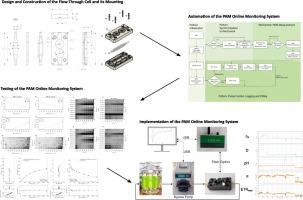Online monitoring system for microalgal bioprocesses: Model-based quantification of photosynthetic activity using pulse amplitude modulation fluorometry and rapid light curves
IF 4.5
2区 生物学
Q1 BIOTECHNOLOGY & APPLIED MICROBIOLOGY
Algal Research-Biomass Biofuels and Bioproducts
Pub Date : 2025-10-01
DOI:10.1016/j.algal.2025.104230
引用次数: 0
Abstract
Microalgae biotechnology has significant potential, particularly with respect to circular bioeconomy and biorefinery concepts. To fully exploit this potential, efficient bioprocessing strategies are required in order to achieve high product yields. In this context, microalgal bioprocess monitoring is crucial to ensure an efficient microalgal cultivation and in turn achieve higher productivity. This study focuses on the design, construction, automation, experimental testing and implementation of an online monitoring system based on a pulse amplitude modulation (PAM) fluorometer using rapid light curves (RLCs) for model-based quantification of microalgal photosynthetic activity as an indicator of biomass quality. The first step was to design and construct a flow-through cell including its mounting to ensure reproducible measurements. Next, a protocol was programmed to automate the measurement procedure and allow online monitoring of microalgae cultivations in photobioreactors. The system was then tested using the microalga Microchloropsis salina at optical densities ranging from about 1 to 23 corresponding to biomass concentrations from about 0.25 to 5.00 g L−1. At distinct concentrations within this range, RLCs were determined and mathematical models describing light limitation and inhibition of the photosynthetic system were applied to the data in order to identify RLC model parameters and to determine the most appropriate models. Finally, the system was implemented via its bypass in a photobioreactor operating in batch and turbidostatic mode, with the RLC model parameters monitored online. As a major result, the study showed that pH stress can be detected by RLC model parameters shifts. Overall, the study demonstrated the system's capability to monitor photosynthetic activity online, offering valuable applications in microalgal biotechnology and bioprocess engineering.

微藻生物过程在线监测系统:利用脉冲幅度调制荧光法和快速光曲线对光合活性进行基于模型的量化
微藻生物技术具有巨大潜力,特别是在循环生物经济和生物炼制概念方面。为了充分利用这一潜力,需要有效的生物处理策略,以实现高产品产量。在这种情况下,微藻生物过程监测是至关重要的,以确保有效的微藻培养,从而实现更高的生产力。本研究的重点是基于脉冲幅度调制(PAM)荧光计的在线监测系统的设计、构建、自动化、实验测试和实现,该系统使用快速光曲线(rlc)对微藻光合活性进行基于模型的量化,作为生物量质量的指标。第一步是设计和构建一个流动单元,包括其安装,以确保测量的可重复性。接下来,编写了一个协议,使测量过程自动化,并允许在线监测光生物反应器中的微藻培养。然后使用微藻盐绿藻(Microchloropsis salina)对该系统进行测试,光密度范围为约1至23,对应的生物量浓度约为0.25至5.00 g L−1。在此范围内的不同浓度下,测定了RLC,并将描述光限制和光合系统抑制的数学模型应用于数据,以确定RLC模型参数并确定最合适的模型。最后,该系统通过旁路在间歇式和浊积模式下的光生物反应器中运行,并在线监测RLC模型参数。主要结果表明,pH胁迫可以通过RLC模型参数的变化来检测。总的来说,该研究证明了该系统在线监测光合活动的能力,为微藻生物技术和生物过程工程提供了有价值的应用。
本文章由计算机程序翻译,如有差异,请以英文原文为准。
求助全文
约1分钟内获得全文
求助全文
来源期刊

Algal Research-Biomass Biofuels and Bioproducts
BIOTECHNOLOGY & APPLIED MICROBIOLOGY-
CiteScore
9.40
自引率
7.80%
发文量
332
期刊介绍:
Algal Research is an international phycology journal covering all areas of emerging technologies in algae biology, biomass production, cultivation, harvesting, extraction, bioproducts, biorefinery, engineering, and econometrics. Algae is defined to include cyanobacteria, microalgae, and protists and symbionts of interest in biotechnology. The journal publishes original research and reviews for the following scope: algal biology, including but not exclusive to: phylogeny, biodiversity, molecular traits, metabolic regulation, and genetic engineering, algal cultivation, e.g. phototrophic systems, heterotrophic systems, and mixotrophic systems, algal harvesting and extraction systems, biotechnology to convert algal biomass and components into biofuels and bioproducts, e.g., nutraceuticals, pharmaceuticals, animal feed, plastics, etc. algal products and their economic assessment
 求助内容:
求助内容: 应助结果提醒方式:
应助结果提醒方式:


